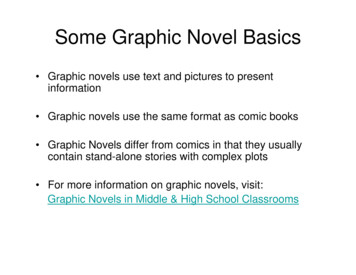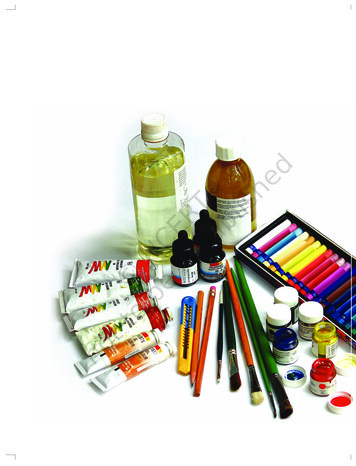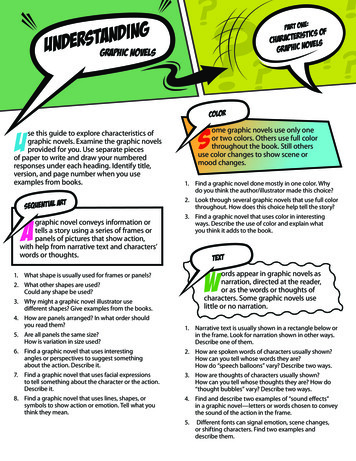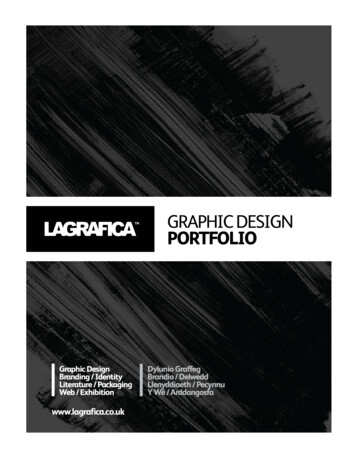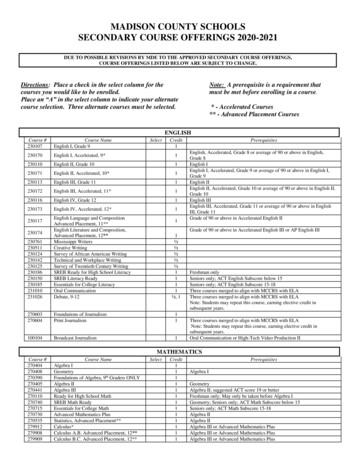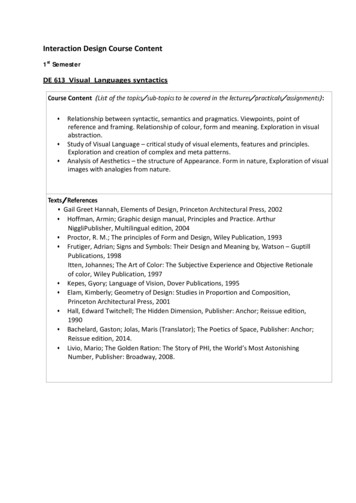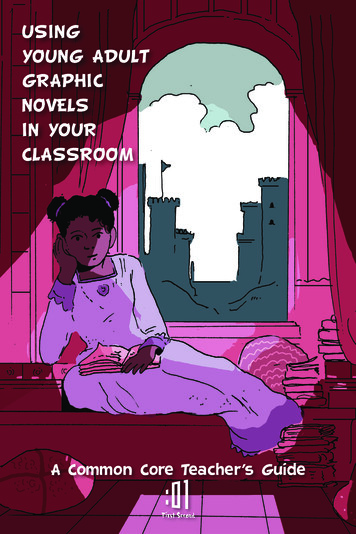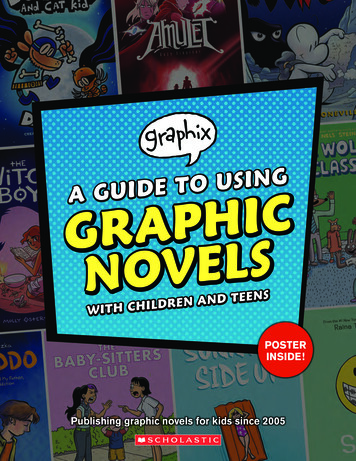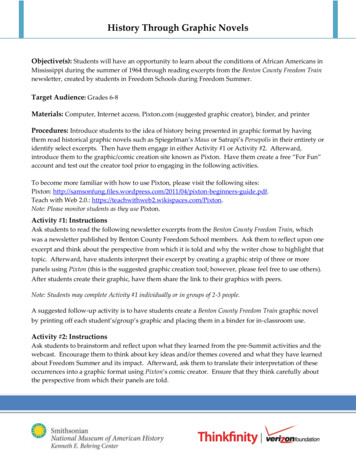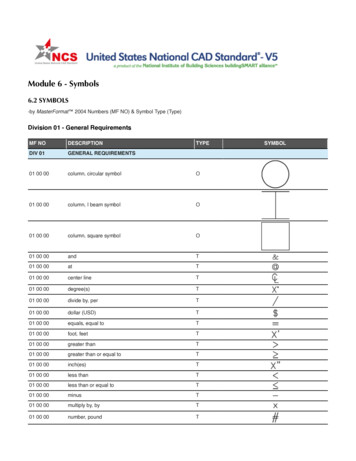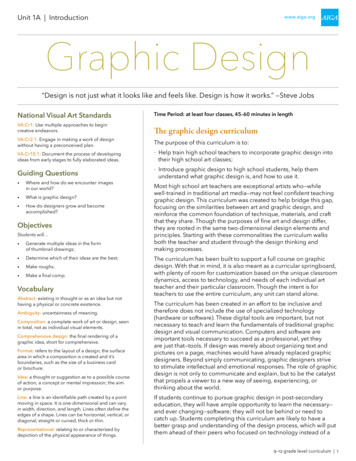
Transcription
Unit 1A Introductionwww.aiga.orgGraphic Design“Design is not just what it looks like and feels like. Design is how it works.” —Steve JobsNational Visual Art StandardsVA:Cr1: Use multiple approaches to begincreative endeavors.VA:Cr2.1: Engage in making a work of designwithout having a preconceived plan.Time Period: at least four classes, 45–60 minutes in lengthThe graphic design curriculumThe purpose of this curriculum is to:VA:Cr10.1: Document the process of developingideas from early stages to fully elaborated ideas. Help train high school teachers to incorporate graphic design intotheir high school art classes;Guiding Questions Introduce graphic design to high school students, help themunderstand what graphic design is, and how to use it. here and how do we encounter imagesWin our world? What is graphic design? ow do designers grow and becomeHaccomplished?ObjectivesStudents will Generate multiple ideas in the formof thumbnail drawings; Determine which of their ideas are the best; Make roughs; Make a final comp.VocabularyAbstract: existing in thought or as an idea but nothaving a physical or concrete existence.Ambiguity: uncertainness of meaning.Composition: a complete work of art or design, seenin total, not as individual visual elements.Comprehensive design: the final rendering of agraphic idea, short for comprehensive.Format: refers to the layout of a design, the surfacearea in which a composition is created and it’sboundaries, such as the size of a business cardor brochure.Idea: a thought or suggestion as to a possible courseof action; a concept or mental impression; the aimor purpose.Line: a line is an identifiable path created by a pointmoving in space. It is one-dimensional and can varyin width, direction, and length. Lines often define theedges of a shape. Lines can be horizontal, vertical, ordiagonal, straight or curved, thick or thin.Representational: relating to or characterized bydepiction of the physical appearance of things.Most high school art teachers are exceptional artists who—whilewell-trained in traditional art media—may not feel confident teachinggraphic design. This curriculum was created to help bridge this gap,focusing on the similarities between art and graphic design, andreinforce the common foundation of technique, materials, and craftthat they share. Though the purposes of fine art and design differ,they are rooted in the same two-dimensional design elements andprinciples. Starting with these commonalities the curriculum walksboth the teacher and student through the design thinking andmaking processes.The curriculum has been built to support a full course on graphicdesign. With that in mind, it is also meant as a curricular springboard,with plenty of room for customization based on the unique classroomdynamics, access to technology, and needs of each individual artteacher and their particular classroom. Though the intent is forteachers to use the entire curriculum, any unit can stand alone.The curriculum has been created in an effort to be inclusive andtherefore does not include the use of specialized technology(hardware or software). These digital tools are important, but notnecessary to teach and learn the fundamentals of traditional graphicdesign and visual communication. Computers and software areimportant tools necessary to succeed as a professional, yet theyare just that—tools. If design was merely about organizing text andpictures on a page, machines would have already replaced graphicdesigners. Beyond simply communicating, graphic designers striveto stimulate intellectual and emotional responses. The role of graphicdesign is not only to communicate and explain, but to be the catalystthat propels a viewer to a new way of seeing, experiencing, orthinking about the world.If students continue to pursue graphic design in post-secondaryeducation, they will have ample opportunity to learn the necessary—and ever changing—software; they will not be behind or need tocatch up. Students completing this curriculum are likely to have abetter grasp and understanding of the design process, which will putthem ahead of their peers who focused on technology instead of a9–12 grade level curriculum 1
Unit 1A Graphic Design IntroductionRough sketch: a mid-stage development of a graphicidea, often shown to a client for approval.Shape: the form of an object or its external boundary,outline, or external surface, as opposed to otherproperties such as color, texture, etc.Texture: an interwoven pattern of light and dark tonesthat imparts a physical quality to a surface—rough,smooth, etc.Thumbnail sketch: a small sketched idea, a fast way togenerate multiple ideas.Ubiquitous: present, appearing, or found everywhere.Materialswww.aiga.orgsolid design foundation. Successful design comes from empathetic,thinking people, not machines and technology.The curriculum will give high school students exposure to the designprocess and design problems as a way of introducing them to visualcommunication. The curriculum includes: Unit 1: Introduction to Graphic Design Unit 2: 2D Design Basics—Points, Lines, and Planes;Gestalt—Shape, Balance, Rhythm, Unity; Color Unit 3: Design Process—Define the Problem; Learn;Generate Ideas; Design Development; Implementation Black markers Unit 4: Typography—Typography in Action; The Language of Type;Font Pairing and Hierarchy Colored pencilsPencils Unit 5: References; Glossary Plain paper (8½" 11") Printouts of the thumbnail and rough templates Sheet protectors and a three ring binder for eachstudent (optional)Figures1. The Universal Arts of Graphic Design2. Examples of Assignment 13. Examples of Assignment 2—thumbnail sketches,rough sketches, and final comprehensive design4. Examples of Assignment 35. Examples of Assignment 4Art Context, CulturalConnections and RelevancyGraphic design is a ubiquitous art form. We areexposed to thousands of ads every day, on TV,billboards, radio, on the web. Graphic design isliterally everywhere.Personal computers have made it possible for anyoneto make their own brochures, signs, and other visualcommunication. However, many people think thatdesigning something involves using a lot of fancyfonts, finding some clip art, and that’s it.This curriculum has been created with the needs of both studentsand teachers in mind. Adhering to the National Visual Arts andK–12 curriculum standards, the curriculum is designed not only tobe educational for students, but also practical for art teachers toapply in their classrooms, while still meeting current art standards.In addition to visual communication, a core focus of this curriculumis design thinking: a strategic form of creative problem solving thatis not limited to graphic design—or even art—but is being applied toproblems as diverse as land use and traffic flow, to agriculture andengineering. While the curriculum has been created to help preparestudents interested in pursuing graphic design at the college oruniversity level, its focus is on how people communicate visuallyand how to utilize design thinking to help students prepare for anyoccupational or academic field they may choose.An introduction to graphic designIn the intro to their documentary The Universal Arts of Graphic Design,(see Figure 1) PBS Digital Studios describes graphic design thusly:“Though often overlooked, Graphic Design surrounds us: it is thesigns we read, the products we buy, and the rooms we inhabit.Graphic designers find beauty within limitations, working towardsthe ultimate goal of visually communicating a message. Utilizing alanguage of type and imagery, graphic designers try to make everyaspect of our lives defined and beautiful.”Design is not decoration, it is problem solving. Thiscurriculum walks students through the design processand gives them lots of practice solving problem inorder to grow their skills as graphic designers.Handouts Handout 1A.1-Thumbnails.pdf Handout 1A.2-Roughs.pdfFIGURE 1: The Universal Arts of Graphic Design (www.pbs.org/video/2311391293), PBS, Digital Studios.9–12 grade level curriculum 2
Unit 1A Graphic Design Introductionwww.aiga.orgWhile this is a good “nutshell” description of graphic design, incontemporary society, design has grown beyond only being ameans to organize a visually cluttered environment, or to persuade,inform, and organize an audience to meet the needs of business andindustry. Design has become, as Richard Grefé, former ExecutiveDirector of AIGA, defined it, “the intermediary between informationand understanding.” Properly applied, effective design—designwhich solves specific problems—can influence individual and groupbehavior, political policy, and even society.While traditionally the term “graphic design” has referred to twodimensional surface design—the arrangement of text, images, andcolor to express a message—the discipline has evolved to incorporatethree-dimensional objects and spaces, and time-based audio/visual experiences. As graphic designers now find work in everyfield from publishing to entertainment, the sciences to finance, andare incorporating traditional media such as print and television withnew and emerging technologies such as smart phones and virtualreality, now more than ever, design education is a lifelong endeavor.By focusing on the visual communicative fundamentals of art anddesign, in combination with creative thinking and problem solvingas opposed to technology, this curriculum aims to prepare studentsto be lifelong learners able to thrive as the methods of informationcommunication and consumption continue to change.In addition to design studios and advertising agencies, graphicdesigners also work as in-house talent for companies, fortraditional and for new media content creators and publishers,and even as individual entrepreneurs. The practice of design ishighly collaborative, and designers frequently work with writers,illustrators, photographers, printers, advertisers, marketers andother professionals.A brief list of careers in graphic design includes: advertising (promotional) design book design book jacket design brand and identity design corporate communication design editorial design environmental design interactive (experience) design illustration information design motion design package design publication design retail design wayfinding designBeyond these more traditional roles, designers are finding theircreative problem solving and communication skills in demand in agrowing list of industries, including government and public policy,9–12 grade level curriculum 3
Unit 1A Graphic Design Introductionwww.aiga.orginsurance, health care, architecture, environmental services, andengineering. Graphic design is a competitive and ever-evolvingprofession that offers an expanding and rewarding number of careerpaths to the curious, determined, and hard working.One of the key skills all designers must develop is a sensitivity to andawareness of the activity in the larger design community. For studentsjust beginning their design education, knowing where to look canbe confusing. In addition to traditional periodicals such as Print andCommunication Arts, portfolio sites such as Bēhance.net can exposestudents to the work of professional and student designers from allover the world. As students begin the curriculum, ask them to findand follow at least ten designers (via Bēhance, Instagram, or Pinterest)who they find inspiring.ACTIVITY PROCESSEngagement (the hook—motivation and relevancy)Ask students what they think graphic design is. How did theirperspectives change after being introduced to graphic design? Howdoes their design compare to professional design? Just becauseeveryone can do it (access to desktop publishing software), doesn’tmean everyone can do it effectively. Learning basic graphic designskills will enable students to become more confident communicatorsand create effective design solutions.days 1–4The Elements of DesignAt the beginning of the curriculum, easing students into their startwith graphic design and the design process is important. One of themost difficult aspects of design for students to initially grasp is thatgraphic design is seldom a representational depiction of an object,but more often an abstract image that communicates a largeridea. The following exercises can be thought of as ice-breakers tointroduce students to the way graphic designers work out solutionsto problems.Another challenge for students when beginning a design class is thatthey often become attached to their first idea, and as a result, havedifficulty coming up with more than one. As graphic designers areexpected to explore many ideas in order to find the best solution toa problem, they use thumbnail sketches (thumbnails—small, quicksketches) to quickly get many ideas down on paper. These thumbnailsketches are then evaluated and further developed into mock-ups ofthe concept, or rough sketches (roughs). It is these rough sketchesthat are often presented to the client as a way of ensuring that thedesigns are on track. Once the rough sketches are approved, they aredeveloped into a finished, neatly executed comprehensive design(comps). By learning and working through this process (see Figure3), generating multiple ideas will be ingrained as part of the designprocess as students move through the curriculum.Assignment 1: Line (see Figure 2)objective: Introduce students to a traditional, multi-step design anddevelopment process (thumbnails, roughs, and comps), while utilizingthe elements and principles of two-dimensional design to solvevisual problems. Another goal is to help students create meaning9–12 grade level curriculum 4
Unit 1A Graphic Design Introductionwww.aiga.orgwith abstract images using the visual elements of design: line,shape, texture, and color (more on this in Unit 2). This process mayfeel awkward at first, as students are used to creating one idea andmaking it into art, but designers generate many possible solutionsto a problem as a way to improve the quality of their work. Makingabstract images allows ambiguity to exist, and ambiguity allows formany interpretations. For example, the final comprehensive design(see Figure 2) could be a closeup of a cow, or fabric floating in thebreeze. Practice is the key to feeling comfortable using the designprocess, and these introductory assignments are designed to givestudents the practice they need to develop confidence in their ideas.specifications: Students must accomplish the following: Create 16 thumbnail sketches for each of the four assignments. Look objectively at their ideas, show them to other students, andevaluate their thumbnail sketches to determine which three ideasare the best, and create three rough sketches for each of the fourexercises. This, too, may feel awkward because it is a new skill. Withpractice, students will feel comfortable evaluating their own andothers' ideas to select the three best ones. Remind them that thereare not just one, but many right ways.FIGURE 2: Examples of Assignment 1. Evaluate their rough sketches, use the same process as above toselect the one they think is best, and create a single, neatly executedcomprehensive design for each of the four assignments.process:1. Have students use letter size plain paper to sketch small ideas.Sometimes students don't know how to get started and just stareat the blank page. If so, a template may be provide (see Handout1A.1-Thumbnails.pdf).2. Using a pencil, have students draw a variety of lines with varyingthickness and distance from each other across the thumbnail box.Repeat for each thumbnail box.3. As students work on their thumbnails, have them experiment withas many different types of line as they can think of—thick, thin, wavy,dotted, etc.4. Students should create 16 unique thumbnails, then evaluate theirwork, and select the three strongest sketches. What makes astrong idea could be composition, great movement, eye-catchingcontrast, or a host of other qualities. Students usually know whena design is successful, but may not have the ability to createsuccessful design themselves until they have practiced many times.5. Have students make their own rough sketch on plain letter-sizedpaper, or provide them with a template (see Handout 1A.2Roughs.pdf).6. Continuing to work in pencil with their three chosen thumbnails,students should develop each thumbnail sketch into a moredeveloped design (roughs). A rough is drawn more neatly andwith more care than a thumbnail, and can be started in pencil andcompleted with a black marker.9–12 grade level curriculum 5
Unit 1A Graphic Design Introductionwww.aiga.org7. When their roughs are complete, have students evaluate their workand select the strongest rough. If they don't know which is thestrongest, they can ask you or other students for help. Continuallyrefining their work strengthens and develops their design sense.8. With their chosen rough, students can now create their final compon a clean sheet of plain letter-size paper. Students should developtheir concept into a neatly executed comprehensive design,working first in pencil and then finishing the comp in black marker.Assignment 2: Shape (see Figure 3)process:1. Provide students with the pre-printed thumbnail sheets (seeHandout 1A.1-Thumbnails.pdf), or have them work on plain, lettersize paper if they prefer.2. Using a pencil, have the students draw four shapes that havesimilar qualities (e.g. four geometric shapes or four organic shapes)in each thumbnail box.3. As students work on their thumbnails, challenge them to arrangethe shapes in each thumbnail so as to allow the viewer’s eye tomove from one shape to the other with ease.4. Students should create 16 unique thumbnails, and then evaluate theirwork using the same process they did in the line assignment, selectingthe three sketches they feel are the strongest or most successful.5. Provide students with the pre-printed rough sheets (see Handout1A.2-Roughs.pdf), or have them make their own rough sheets onplain letter-size paper.6. Working from their three chosen thumbnails, have studentsdevelop each sketch into a more developed design, working first inpencil and then finishing each design in black marker.7. When their roughs are complete, have students evaluate their workand select the rough they feel is the most successful. They can askfor feedback from the teacher and other students before they maketheir decision.8. On a clean sheet of plain paper and working from their chosenrough, have students develop their concept into a neatly executedcomprehensive design, working first in pencil and then finishingthe comp in black marker.Assignment 3: Texture (see Figure 4)process:1. Provide students with the pre-printed thumbnail sheets (seeHandout 1A.1-Thumbnails.pdf), or have them draw their thumbnailsketches on plain letter-sized paper.2. Using a pencil, have the students draw different textures (e.g. across hatched basket weave or a “sandy” texture made of closelydrawn dots) in each thumbnail box.FIGURE 3: Examples of Assignment 2—thumbnail sketches, roughsketches, and final comprehensive design. These thumbnails,roughs, and final comp showcase a student’s sketching process. Thestudent is exploring black and white shapes in relationship to thespecific format (the rectangle’s edges).3. As students work on their thumbnails, challenge them to see whattextures they can create using other materials they find in theclassroom (e.g., chalk, charcoal sticks, carpet, ceiling). Ask them toimagine how they might recreate the texture made by those toolsgraphically with their black markers.9–12 grade level curriculum 6
Unit 1A Graphic Design Introductionwww.aiga.org4. Students should create 16 unique thumbnails, and then evaluatetheir work, selecting the three sketches they feel are the strongest.They can ask for feedback from other students before they maketheir decision.5. Provide students with the pre-printed rough sheets (see Handout1A.2-Roughs.pdf), or have them make their rough drawings onplain letter-size paper.6. Working from their three chosen thumbnails, have studentsdevelop each sketch into a more developed design, working first inpencil and then finishing each design in black marker.7. When their roughs are complete, have students evaluate their workand select the rough they feel is the strongest.8. On a clean sheet of plain paper and working from their chosenrough, have students develop their concept into a neatly executedcomprehensive design, working first in pencil and then finishingthe comp in black marker.Assignment 4: Color (see Figure 5)process:FIGURE 4: Examples of Assignment 3.1. Provide students with the pre-printed thumbnail sheets (seeHandout 1A.1-Thumbnails.pdf), or have them make their thumbnailsketches on plain letter-size paper.2. Using pencil, have the students draw thumbnails for 16 differentabstract patterns.3. As students work on their thumbnails, refer students to the workthey made in Assignments 1–3, and challenge them to createdesigns that make different use of line, shape, and texture, and thatcreate different focal points for the viewer.4. Once students have 16 unique thumbnails in pencil, have themapply two contrasting colors of the purest hue (e.g. purple asopposed to violet red, green as opposed to yellow green) to theirthumbnails. Challenge the students to consider what could happenwhen the colors overlap, or how the design might change if theyleave certain areas white.5. With their two colors applied, have students evaluate their work,selecting the three sketches they feel are the strongest.6. Provide students with the pre-printed rough sheets (see Handout1A.2-Roughs.pdf), or have them make their rough drawings onplain letter-size paper.7. Working from their three chosen thumbnails, have studentsdevelop each sketch into a more developed design. In each rough,have students use different hues of their chosen colors (e.g. addingviolet red to purple, or lime to green) to create a sense of motionor energy, calm or stillness in each design.8. When their roughs are complete, have students evaluate their workand select the rough they feel is the strongest.FIGURE 5: Examples of Assignment 4. In-progress thumbnailsketches (top) and finished comp. Note the limited colors in thethumbnail sketches have been expanded in the finished design todraw the viewer’s eye to the lower left corner.9. On a clean sheet of plain paper and working from their chosenrough, have students develop their concept into a neatly executedcomprehensive design, working first in pencil and then finishingthe comp by making use of their full set of colored pencils.9–12 grade level curriculum 7
Unit 1A Graphic Design Introductionwww.aiga.orghints: When coloring in their work, if students place a clean sheet ofpaper between their hand and their work, it won't smudge.Adaptations and AccommodationsIf students have limited motor skills, encourage them to do the bestthey can and try to improve. If they are unable to use their hands asneeded, they could use a computer to complete the assignment, orstudents could work in pairs. They could also try thicker drawing toolssuch as markers or fat pencils.ExtensionsThere are many insightful readings devoted to rhythm and balancethat would make a nice accompanying text to the assignments in thisunit (see Unit 5A References). Go over the content in class, if desired.Homework or Independent WorkIf students need more to do, they could create their own symmetryand asymmetry drawings like the example on page 26 of GraphicDesign: The New Basics book, cut patterns out of paper as shownon page 27, or take photos of repetition and rhythm, as shown onpages 28–29.ClosureHave students put their four, finished comps on the wall and look atthem together. Ask the students if they can detect a unifying factorbetween each of their comps, or if they appear as unrelated pieces?Ask the students to identify what they might do differently if theywere to repeat the exercise to unify the four designs. Task studentswith making use of the thumbnail, rough, and comp techniques incompleting their assignments for Units 2–4 (more in Unit 3).Checks For UnderstandingEarly in the curriculum students may have difficulty coming up withabstract, nonrepresentational ideas for images. If so, ask them toenlarge a detail from an object in the classroom (e.g. the pull tabon a soft drink can or the cap of a pen) in their thumbnail squareuntil it is too large to be recognizable. Encourage students to talkwith one another as they sketch and compare their use of line,shape, and color introduced in this unit (more in Unit 2). Seeingothers' work will spark discussion and new ideas of their own.It's alright if students are influenced in part by another person'sdesign. This is how new designers can improve their work.Check each student as they work, reinforcing the vocabulary andprinciples with feedback and critique, asking questions to ensurecomprehension.Lesson Assessment Based On ObjectivesStudents should be assessed on their ability to demonstrate anawareness of what line, shape, texture and color are, and applythose concepts to their own work. They need to exhibit a willingnessto come up with sixteen ideas for each exercise, and then practicelooking and evaluating which they determine to be their best threeconcepts to rough out. The care they take in making their final compreflects how they feel about their work: are they doing it to just get itdone, or are they trying to make it the best they can?9–12 grade level curriculum 8
Unit 1A Graphic Design Introductionwww.aiga.orgThe correct use of unit vocabulary in class dialog and in verbalreflection should be accurate and appropriate to the work they makeand see. All work produced in and out of class should be collectedand analyzed. (See Unit 1A Rubric.docx for assessment and rubricideas. Customize to meet class specific assessment needs.)AIGA Minnesota Innovate grant funded projectwww.aigaminnesota.orgAIGA is the profession’s oldest and largest professional membership organization for design—with 70 chapters and more than25,000 members—they advance design as a professional craft,strategic advantage, and vital cultural force. From content thatdefines the global practice to events that connect and catalyze,they work to enhance the value and deepen the impact of designacross all disciplines on business, society, and our collective future.9–12 grade level curriculum 9
An introduction to graphic design In the intro to their documentary The Universal Arts of Graphic Design, (see Figure 1) PBS Digital Studios describes graphic design thusly: “Though often overlooked, Graphic Design surrounds us: it is the sign
